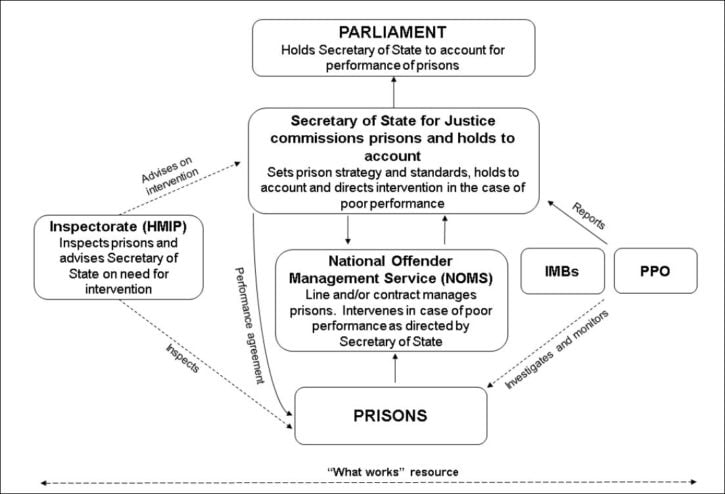Prison Safety and Reform white paper
This lunchtime (3 November 2016) the Ministry of Justice published its white paper on prison reform, Prison Safety and Reform. This post merely summarises the main points of the white paper with further analysis to follow over the coming days.
Interestingly, the document retains the same unapologetic tone in its advocacy for penal reform used by Justice Secretary Liz Truss’ predecessor Michael Gove. The paper is also strong in its vision of reform needing to be led by practitioners, not just prison governors but frontline staff:
Governors will be backed by prison staff who are not just security guards and minders but also mentors. Staff will have the resources, authority and tools needed to break through the road blocks to reform and take on the challenge of transforming lives. Greater levels of autonomy for the frontline will accompany greater transparency for the public and Parliament.
What is a white paper?
White papers are policy documents produced by the Government that set out their proposals for future legislation. White Papers are often published as Command Papers and may include a draft version of a Bill that is being planned. This provides a basis for further consultation and discussion with interested or affected groups and allows final changes to be made before a Bill is formally presented to Parliament.
This white paper, contrary to expectations, does not float ideas and promise expert consultation but sets out a clear vision for prison reform, albeit one which inevitably begs many questions, particularly of the “how” and “when” variety.
Safety
Unsurprisingly, given the very substantial increases in violence and self-harm in prisons over recent years, the white paper prioritises this issue with the main response being a promise of an extra 2,500 frontline prison staff at a cost of £104m per year. The announcement follows an emergency £14m funding package last month to recruit 400 extra officers in 10 of the least safe prisons in the country.
The challenge for the MoJ will be to recruit new, good quality staff while retaining the experience staff who have been leaving in droves (or going off on long-term sick) in the last three years in response to working in an increasingly violent and under-staffed environment.
The white paper sets out a three-pronged approach: more recruiting of ex-armed forces personnel; a new graduate entry scheme and apprenticeships.

Drugs
The other area prioritised in the white paper is tackling drugs, particularly the recent increase in the use of New Psychoactive Substances (NPS) inside (for the best account of the issue, check out my summary of the User Voice report). Responses include:
- Drug tests on reception and release for all prisoners
- New standards to get prisoners off drugs and into work
- No-fly zones over prisons to try to stop drugs being delivered by drones
- 300 new sniffer drugs apparently trained to detect NPS
Clearly drugs is a major issue and the MoJ needs to do everything it can to restrict availability. However, experience tells us that it is impossible to keep drugs out of prison (or any community; even post-war East Berlin had a raging heroin problem despite the wall and four occupying armies). There needs to be increased emphasis on drugs education and treatment and, most importantly, getting prisoners out of their cells and into constructive activities.
The User Voice report concluded that prisoners are using (highly dangerous and unpredictable) NPS as a “bird-killer”; it is no surprise that use has escalated during a period when prisoners have spent longer and longer banged up in their cells.
Bluntly, the testing of all prisoners on reception and release appears to be an almighty waste of precious resources. The history of mandatory drug testing has been that it is both an unreliable indicator of drug use in a particular establishment and that it can prompt prisoners to take new drugs which are less easy to detect. (Mandatory Drug Testing was found to be a key factor in introducing many prisoners to heroin since it is detectable in the body for only 2-3 days compared to up to 28 days for cannabis.)

Reform
However, having taken issues with some of the approaches highlighted in the white paper, there is plenty to applaud. The focus of the paper is on reform as much as on prison safety and the commitment to devolve autonomy to individual prisons seems to be undiluted. It is good to see that one of its seven chapters is dedicated to developing leaders and staff and that one of the four new standards is about preparation for release.
Some of the main points in the white paper are:
“Enshrining in law for the first time what prisons should be delivering, and holding the Secretary of State to account for ensuring they do so.”
This involves strengthening the role of prison inspections and publishing league tables of performance as well as “a clearer framework for the Secretary of State to intervene when prisons are judged to be failing”.
The white paper sets out this new vision in a graphic reproduced below:

Four new quality standards (from which the league tables will be created:
- Public protection (ensuring that prisoners don’t escape and a hint about more use of temporary release)
- Safety and order (prisons will be required to reduce both the number of assaults — on staff and prisoners — and the incidence of self-harm)
- Reform (targets around health and substance misuse, work, education and contact with families)
- Preparing for life after prison (measuring employment, accommodation and education on release)
£1.3 billion refurbishment scheme closing the more “dilapidated” prisons.
This will involve creating more than 10,000 new prison places, building 5 new “community prisons” for women; although no information is given on which prisons will be shut down.
Giving prison governors much more autonomy.
The white paper promises to: “put the governor at the centre of all services in prison by devolving budgets and control, and providing them with the levers they need to hold other providers to account.”
Conclusion
Although I’ve not had time to read the document with the care and attention it deserves, my initial reaction is to be rather pleased, certainly after the official press release which focused much more on safety and drugs with little about the larger reforms.
There were concerns, shared by many, that the white paper would focus almost entirely on prison safety and miss the opportunity for reform. Clearly, there can be no reform without a much safer living environment but I remain of the opinion that we can only achieve a safer, fairer and more constructive (even rehabilitative) prison system without real reform which engages the commitment of prison staff and others involved in delivering healthcare, drug treatment, education etc.
I do question the merit of league tables and wonder how measures will be achieved in practice; but even here there is the positive commitment to shared outcomes for prisons and probation.
The white paper does at least leave me cautiously looking forwards to the next announcements from the MoJ on how they intend to implement their vision for reform.
Please share your views via the comments section below.
You can also see more detail about the MoJ plans to improve prison safety here and more information about the detail and proposed timetable for devolving autonomy to prison governors here.









6 Responses
Waste of time more fluff, cut staff way below safe levels have little chance of recovery.
I think a large number of the current problems were caused by Grayling – slashing staff reduced security and dispensed with the most experienced staff: this together with overcrowding, restricted regimes (some prisoners locked 3 to a cell with an open bucket for a toilet) has led to frustration in prisoners which in turn led to increased drug taking and more violence.
The total denial of the massive corruption and smuggling by staff (the only way hundred of phones and kilogrammes of drugs can get in a single prison) has led to drugs and phones being out of control.
Those in the know have always argued that prisons only run with the cooperation of the prisoners – Grayling destroyed that and we can now see the price of it.
Many thousands of people are unnecessarily imprisoned, be it low-level things such as begging or breaking ASBO type orders, the unnecessary recalls, high level of pointless remands, and, of course, the 4,000 IPPs, many way over tariff.
The only way to sort it out is to not be scared of the tabloid vitriol, not be scared of taming the POA and bringing our prisons into the 21st century (most are still in the 19th in both structure and attitude). This will involve much infrastructure work and professionalising staff; it will involve accepting prisoners as individuals and dispensing with the services of empire builders and the swathes of unqualified psychologists who, with the wave of a pen, can stimie a prisoner’s release.
It will also involve listening to people who know be it staff, prisoner or organisation.
Hi Paul
Thanks very much for your comment, incidentally tackling staff corruption does feature in the white paper.
My view is that there is some hope in the devolved approach and it is up to us all to try to create positive models at a local level (by listening to prisoners and staff) that can be taken up across the system.
Best Wishes
Russell
Hi Russell,
Thank you for your excellent insight into the way things appear to be panning out. I am unsure as to how the MOJ envisages the engagement of the VCS and the future of the private sector CRCs. Can you assist please?
Aye,
Trevor
Hi Trevor
MoJ is current reviewing probation and I understand this is one of the issues they’re looking at – due to report in “Spring.”
Best Wishes
Russell
Hi Russell, mine is a question.I don’t know if you have a program whereby you support the upcoming private institutions, that deal with reforming prisoners?Kindly get back to me,am waiting.